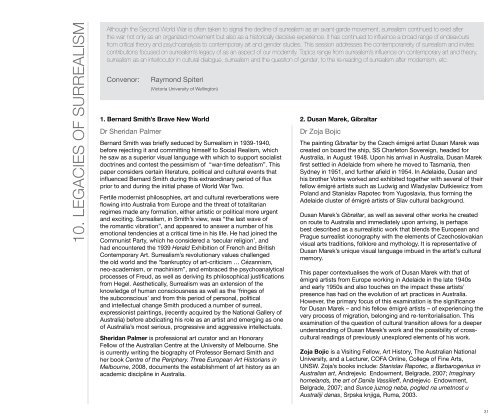2009 AAANZ Conference Abstracts - The Art Association of Australia ...
2009 AAANZ Conference Abstracts - The Art Association of Australia ...
2009 AAANZ Conference Abstracts - The Art Association of Australia ...
Create successful ePaper yourself
Turn your PDF publications into a flip-book with our unique Google optimized e-Paper software.
10. LEGACIES OF SURREALISM<br />
Although the Second World War is <strong>of</strong>ten taken to signal the decline <strong>of</strong> surrealism as an avant-garde movement, surrealism continued to exist after<br />
the war not only as an organized movement but also as a historically decisive experience. It has continued to influence a broad range <strong>of</strong> endeavours<br />
from critical theory and psychoanalysis to contemporary art and gender studies. This session addresses the contemporaneity <strong>of</strong> surrealism and invites<br />
contributions focused on surrealism’s legacy <strong>of</strong> as an aspect <strong>of</strong> our modernity. Topics range from surrealism’s influence on contemporary art and theory,<br />
surrealism as an interlocutor in cultural dialogue, surrealism and the question <strong>of</strong> gender, to the re-reading <strong>of</strong> surrealism after modernism, etc.<br />
Convenor:<br />
1. Bernard Smith’s Brave New World<br />
Dr Sheridan Palmer<br />
Raymond Spiteri<br />
(Victoria University <strong>of</strong> Wellington)<br />
Bernard Smith was briefly seduced by Surrealism in 1939-1940,<br />
before rejecting it and committing himself to Social Realism, which<br />
he saw as a superior visual language with which to support socialist<br />
doctrines and contest the pessimism <strong>of</strong> “war-time defeatism”. This<br />
paper considers certain literature, political and cultural events that<br />
influenced Bernard Smith during this extraordinary period <strong>of</strong> flux<br />
prior to and during the initial phase <strong>of</strong> World War Two.<br />
Fertile modernist philosophies, art and cultural reverberations were<br />
flowing into <strong>Australia</strong> from Europe and the threat <strong>of</strong> totalitarian<br />
regimes made any formation, either artistic or political more urgent<br />
and exciting. Surrealism, in Smith’s view, was “the last wave <strong>of</strong><br />
the romantic vibration”, and appeared to answer a number <strong>of</strong> his<br />
emotional tendencies at a critical time in his life. He had joined the<br />
Communist Party, which he considered a ‘secular religion’, and<br />
had encountered the 1939 Herald Exhibition <strong>of</strong> French and British<br />
Contemporary <strong>Art</strong>. Surrealism’s revolutionary values challenged<br />
the old world and the “bankruptcy <strong>of</strong> art-criticism … Cézannism,<br />
neo-academism, or machinism”, and embraced the psychoanalytical<br />
processes <strong>of</strong> Freud, as well as deriving its philosophical justifications<br />
from Hegel. Aesthetically, Surrealism was an extension <strong>of</strong> the<br />
knowledge <strong>of</strong> human consciousness as well as the ‘fringes <strong>of</strong><br />
the subconscious’ and from this period <strong>of</strong> personal, political<br />
and intellectual change Smith produced a number <strong>of</strong> surreal,<br />
expressionist paintings, (recently acquired by the National Gallery <strong>of</strong><br />
<strong>Australia</strong>) before abdicating his role as an artist and emerging as one<br />
<strong>of</strong> <strong>Australia</strong>’s most serious, progressive and aggressive intellectuals.<br />
Sheridan Palmer is pr<strong>of</strong>essional art curator and an Honorary<br />
Fellow <strong>of</strong> the <strong>Australia</strong>n Centre at the University <strong>of</strong> Melbourne. She<br />
is currently writing the biography <strong>of</strong> Pr<strong>of</strong>essor Bernard Smith and<br />
her book Centre <strong>of</strong> the Periphery. Three European <strong>Art</strong> Historians in<br />
Melbourne, 2008, documents the establishment <strong>of</strong> art history as an<br />
academic discipline in <strong>Australia</strong>.<br />
2. Dusan Marek, Gibraltar<br />
Dr Zoja Bojic<br />
<strong>The</strong> painting Gibraltar by the Czech émigré artist Dusan Marek was<br />
created on board the ship, SS Charleton Sovereign, headed for<br />
<strong>Australia</strong>, in August 1948. Upon his arrival in <strong>Australia</strong>, Dusan Marek<br />
first settled in Adelaide from where he moved to Tasmania, then<br />
Sydney in 1951, and further afield in 1954. In Adelaide, Dusan and<br />
his brother Voitre worked and exhibited together with several <strong>of</strong> their<br />
fellow émigré artists such as Ludwig and Wladyslav Dutkiewicz from<br />
Poland and Stanislav Rapotec from Yugoslavia, thus forming the<br />
Adelaide cluster <strong>of</strong> émigré artists <strong>of</strong> Slav cultural background.<br />
Dusan Marek’s Gibraltar, as well as several other works he created<br />
on route to <strong>Australia</strong> and immediately upon arriving, is perhaps<br />
best described as a surrealistic work that blends the European and<br />
Prague surrealist iconography with the elements <strong>of</strong> Czechoslovakian<br />
visual arts traditions, folklore and mythology. It is representative <strong>of</strong><br />
Dusan Marek’s unique visual language imbued in the artist’s cultural<br />
memory.<br />
This paper contextualises the work <strong>of</strong> Dusan Marek with that <strong>of</strong><br />
émigré artists from Europe working in Adelaide in the late 1940s<br />
and early 1950s and also touches on the impact these artists’<br />
presence has had on the evolution <strong>of</strong> art practices in <strong>Australia</strong>.<br />
However, the primary focus <strong>of</strong> this examination is the significance<br />
for Dusan Marek – and his fellow émigré artists – <strong>of</strong> experiencing the<br />
very process <strong>of</strong> migration, belonging and re-territorialisation. This<br />
examination <strong>of</strong> the question <strong>of</strong> cultural transition allows for a deeper<br />
understanding <strong>of</strong> Dusan Marek’s work and the possibility <strong>of</strong> crosscultural<br />
readings <strong>of</strong> previously unexplored elements <strong>of</strong> his work.<br />
Zoja Bojic is a Visiting Fellow, <strong>Art</strong> History, <strong>The</strong> <strong>Australia</strong>n National<br />
University, and a Lecturer, COFA Online, College <strong>of</strong> Fine <strong>Art</strong>s,<br />
UNSW. Zoja’s books include: Stanislav Rapotec, a Barbarogenius in<br />
<strong>Australia</strong>n art, Andrejevic Endowment, Belgrade, 2007; Imaginary<br />
homelands, the art <strong>of</strong> Danila Vassilieff, Andrejevic Endowment,<br />
Belgrade, 2007; and Sunce juznog neba, pogled na umetnost u<br />
Australiji danas, Srpska knjiga, Ruma, 2003.<br />
31



